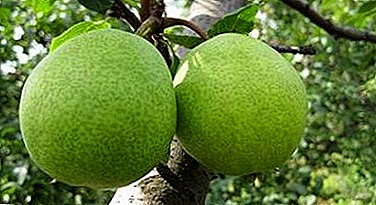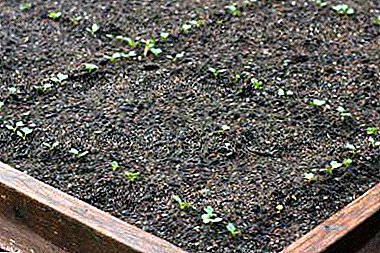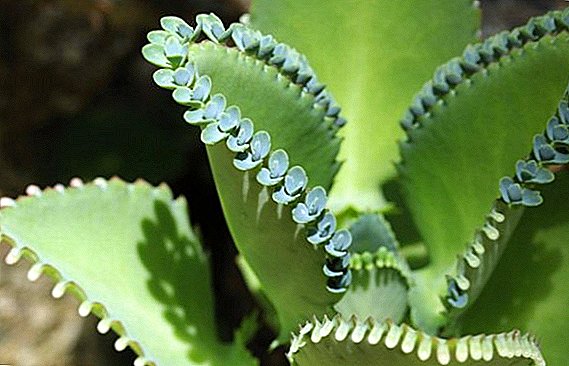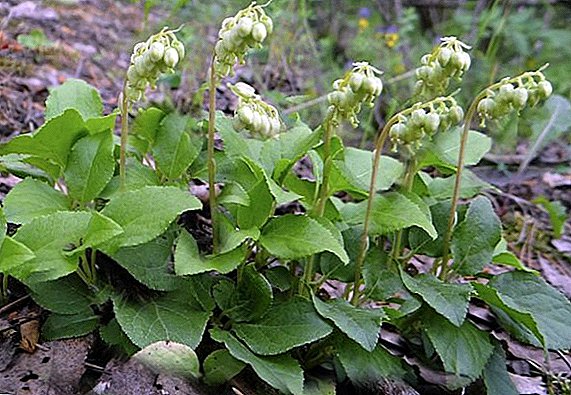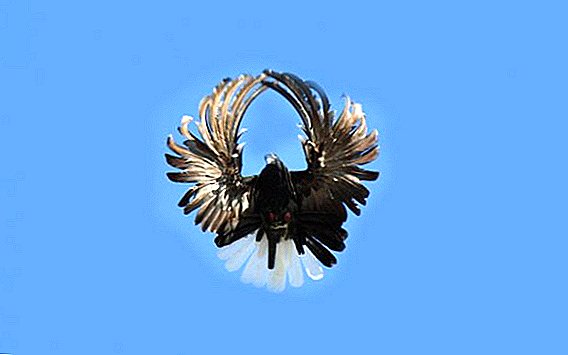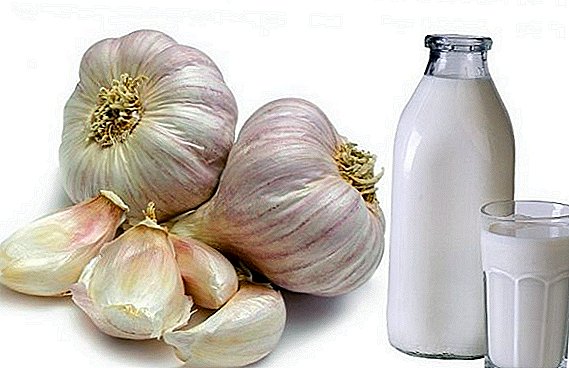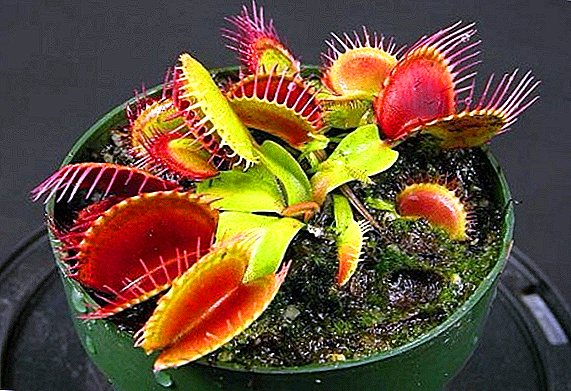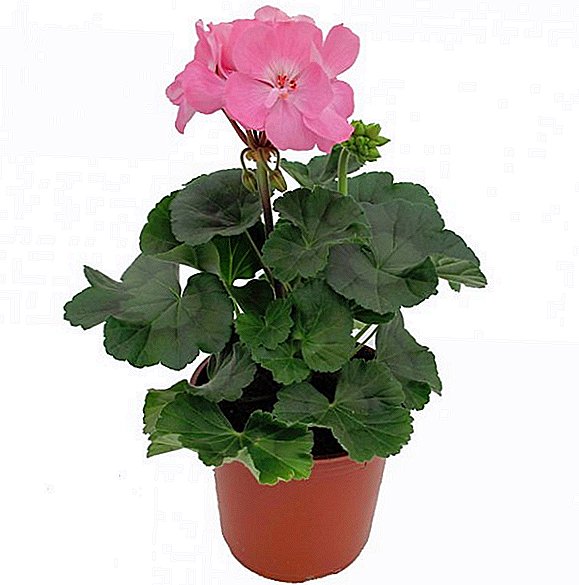 Zone geranium is one of the most popular indoor geraniums. This beautiful plant will decorate not only the room, but also the balcony, it can be planted during the warm season in flowerbeds.
Zone geranium is one of the most popular indoor geraniums. This beautiful plant will decorate not only the room, but also the balcony, it can be planted during the warm season in flowerbeds.
Let's get acquainted with the main varieties of pelargonium zone, with the rules of its cultivation and reproduction, how to deal with diseases and pests.
Botanical description of the plant
Zonal geranium, or, as it is also called, bordered, belongs to the genus Pelargonium of the geranium family, therefore Pelargonium and geranium will correctly call it. This is a perennial heat-loving plant, requiring periodic updates. Like all pelargonium, it has a branched straight stem.
We recommend to learn how to use geranium for medicinal purposes.
Simple, semi-double or terry flowers are gathered in an umbrella and can be white in color or different shades of red, pink or purple. Frequent variegated varieties.  Their main difference from other pelargoniums is that their leaves have a zone of a different color (brown, violet, or white tone), which can disappear under insufficient light.
Their main difference from other pelargoniums is that their leaves have a zone of a different color (brown, violet, or white tone), which can disappear under insufficient light.
| Root system | Caulis |
| Stem | Straight |
| Leaf shape | Palmar or palmar-dissected |
| Leaf color | Green with a different color zone |
| Flower shape | Varied |
| Color of flowers | White, pink, red, burgundy, purple, variegated |
| Fruit Form | Box |
Did you know? Homeland of almost all pelargoniums is the south of the African continent. This genus of plants has about 250 species.
Sorta
Now many varieties of geraniums have been bred with different types of flowers - bouquets (simple flowers), carnations, stellate, cactus flowers, pink flowers (rousbad), tulip flowers, flox flowers.
The height of the bushes, depending on the variety, can be no more than 12.5 cm, and can grow up to 80 cm.
The following groups are most popular:
- Multiblum. Varieties of this type bloom after 70 days, differ in abundant flowering. Semi-double flowers can have a different color and reach up to 3 cm in diameter. The bush grows up to 25-35 cm and can throw up to 15 lush blooming peduncles.
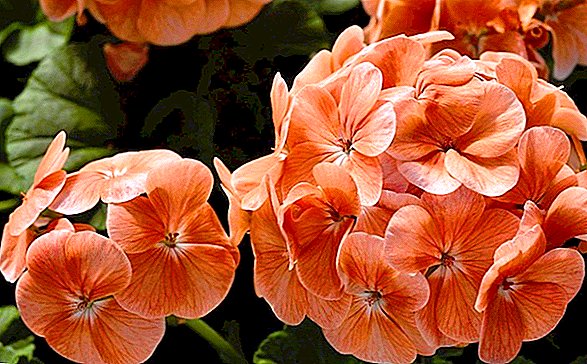
- Chandelier. These are hybrids with bushes about 35 cm high and various colors of lush inflorescences. Chandelier White has large flowers in white. Violet Chandeliers have simple flowers painted in a beautiful purple tone. Scarlet's chandelier has a bright red saturated color. The Bicolor Chandelier has two-tone flowers of raspberry-white color. Fans of multi-colored geraniums can immediately purchase a mix of seeds of the variety Chandeliers. They are interested in the fact that they have a horseshoe-shaped zone on the leaves.
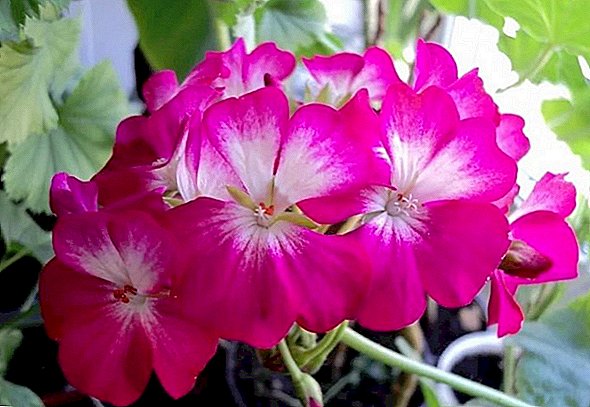
- Nano. This variety group is distinguished by plants up to 20 cm high, which can be used as ground cover plants. Large numerous caps of inflorescences may have different colors, there are bicolor variations.
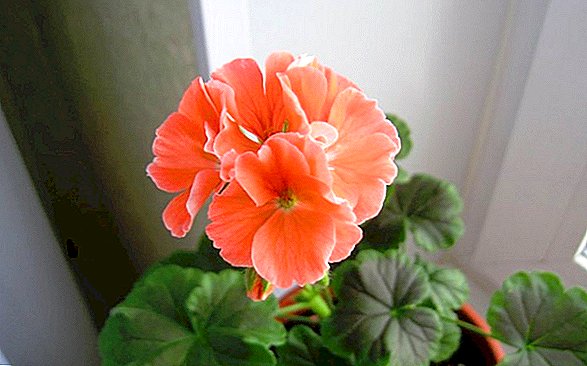
- Rafaella F1. His varied palette of lush (about 12 cm) inflorescences, the ability to bloom all year round and the versatility attract many gardeners.

- Apache F1. Varietal feature of this group of hybrids is the presence of semi-double and double flowers of various colors.
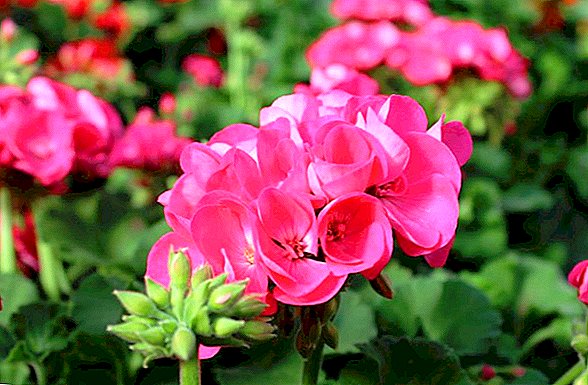
- Tuscany (Toscana). This extensive varietal group is represented by compact bushes of various sizes with magnificent balls. One inflorescence can please with its beauty for about a month, the bush blooms profusely and year-round. Flowers in different varieties can be the most incredible color. For example, in the Toscana Baldo variety, a bush of medium size (about 25 cm) is formed, the petals are pink and the middle center. Toscana Hanna can grow up to 40 cm and has a bright pink color with a white eye. At Toscana Linus, a compact bush and very lush inflorescences are formed from large flowers of soft pink color with a bright crimson center.

- Maverick. These hybrids are distinguished by early flowering and grow to 40 cm. They can have any color.

- Ringo. Forms compact bushes with a height of 30-35 cm, which can be densely planted. Flowers can be different colors.

Did you know? Now a huge number of hybrids of pelargonium bordered - about 75 thousand varieties.
Most hybrids are good both on the windowsill and in the garden or as a balcony plant. You can buy hybrids of geranium zonal for any taste from domestic producers of seeds: Alyona F1 variety of bright red color, salmon Yitka F1, white Blanca F1, pink Yarku F1 and many others.
For those who can not decide on the desired color, you can buy multi-colored mixes:
- Cabaret F2blooming on the hundredth day of emergence;
- Coloram f2growing to half a meter;
- Caprireaching only 20 cm;
- Berry Mixconsisting of pelargonium juicy berry tones.
This is not all varieties that today bred breeders. Flower growers who love pelargonium, there is plenty to choose from. There are varieties of variegated and brown-leaved varieties.  The first ones have somewhat inconspicuous flowers and are grown for showy leaves.
The first ones have somewhat inconspicuous flowers and are grown for showy leaves.
Check out the varieties of tulip geraniums.
Conditions for growing at home
For the successful development and lush flowering of the geranium zone it is necessary to create certain conditions.
Place for a flower
Pelargonium zone likes good lighting, but can tolerate partial shade. It does not fit the northern windows at all, and in the south it is recommended to light a little during the period of hot sun, which can burn its leaves.. The east or west side is best.
In the shade, the plant is drawn out, pales and may not bloom. In the winter period it is recommended to have more light, so that the bushes do not stretch out.
Important! Pelargonium for a uniform formation on the windowsill is recommended to gradually rotate around the axis.
Temperature conditions
Optimum summer temperatures should be within + 18 ... + 25 ° С, in winter a rest period at temperatures of + 10 ... + 14 ° С is desirable. Do not recommend lowering the temperature below + 5 ° C - the plant may freeze.  The transition to the cold period should be gradual, without sudden changes in temperature. Draft must also be absent.
The transition to the cold period should be gradual, without sudden changes in temperature. Draft must also be absent.
Air humidity
Pelargonium tolerates air humidity. Only during the heating season, when the heaters dry the air strongly, it is recommended to humidify it. To do this, you should not use sprays, because of the water droplets on the foliage may remain stains.
It is better to put a container with water next to it or to put a plant pot on a pallet with wet pebbles.
Home care
Zonal geranium belongs to unpretentious indoor flowers, but it will need some care.
Watering
Watering is done as needed - when the upper part of the soil dries out. The frequency of watering depends on the temperature. In the summer heat, pots or culture containers should be watered almost daily, and in the winter, this should be done much less frequently.
Video: how to water geraniums
Do not allow complete drying of the ground or too fill. In the first case, the plant fades, and in the second - can rot the roots. There are no special requirements for water for irrigation, you can even water it with non-settled water, but it should not be cold. Water plentifully, and excess water is drained.
Important! Zonal geranium is better to wet less than to overwet. High humidity for it is fraught with fungal diseases.
Top dressing
To ensure abundant flowering during the growing season, geraniums are fed every 2 weeks. During the winter dormancy, feeding is stopped.
 It is best to alternate between mineral fertilizers and organic. As the first, it is best to use ready-made liquid or dry complexes for pelargoniums ("Garden Club", "Blank sheet for pelargonium", "Royal Mix"). You can use the universal complex fertilizer for flowers ("For flowering plants", "Universal").
It is best to alternate between mineral fertilizers and organic. As the first, it is best to use ready-made liquid or dry complexes for pelargoniums ("Garden Club", "Blank sheet for pelargonium", "Royal Mix"). You can use the universal complex fertilizer for flowers ("For flowering plants", "Universal").
Among the minerals must be potassium, phosphorus, nitrogen, magnesium sulfate will be useful for flowering. As a natural fertilizer you can only use rotten organic matter, but do not abuse it, because it contains a lot of nitrogen.
At home, for abundant flowering pelargonium can be fertilized by such means:
- Milk. Contains many elements required for colors. Milk is diluted with water in a ratio of 1:10.
- Ash. It is a source of important minerals, easily absorbed by plants. In 1 liter of water dilute 1 tbsp. l ash.
- Yeast. Such feeding will improve the state of the root system. In 1 liter of water diluted 3 g of yeast and 2 tbsp. l sugar sand.
- Egg shell. Excellent source of calcium. Ground shells are added to the soil.
Feeding with iodine will be very useful for geranium - it contributes to abundant flowering. In 1 liter of water, dissolve only 1 drop of iodine and pour no more than 50 ml under each plant. Such a tool should not fall on the green part of the geranium, it is introduced along the walls of the planting tank.
Find out more about how to feed geraniums for abundant flowering at home.
Pruning
Zonal geraniums need pruning to form a lush bush, which should be done twice a year. Particularly important pruning at the end of the growing season - in the fall (September-October). At this time, the stems are shortened by 1/3 or 2/3 of the length. Remove weak shoots or growing inside.
In the spring, the shrub is pruned at the end of February or the beginning of March, if it stretches out, and do it carefully, leaving at least 3-5 buds on each shoot.  If the bush winters at low temperatures and does not grow much, it is enough just to pinch the top and the main shoots so that the stems do not stretch. Such pinching for molding can be done throughout the entire period of active growth.
If the bush winters at low temperatures and does not grow much, it is enough just to pinch the top and the main shoots so that the stems do not stretch. Such pinching for molding can be done throughout the entire period of active growth.
At any time, sanitary pruning is done with the removal of yellowed leaves and old branches, flowered inflorescences.
When cutting use disinfected sharp tools. The cut itself is made at an angle and covered with ash, cinnamon or smeared with green.
We recommend to learn how to properly cut and pinch geranium for lush flowering.
Transfer
Transplantation is usually done at the end of February or March. Young zonal geranium bushes are transplanted annually, and old ones - as needed, when the roots fill the entire container. The pot is better to choose clay, the size of the roots or 1-1.5 cm more.
Be sure to have a drainage hole. The drainage itself should be about 2 cm thick. For it you can take pebbles, broken bricks, eggshells, expanded clay.
As the soil, you can take the finished substrate and add a little nitrogenous fertilizer and magnesium sulfate.
Video: how to transplant geraniums When self-compiling the substrate make the following mixtures:
- peat, a layer of fertile soil from the garden, coarse sand in a ratio of 2: 2: 1;
- turf, leaf soil, humus, peat, sand in a ratio of 2: 2: 2: 1: 1.
Important! Transplantation of geranium zonal must be carried out by the method of transshipment, i.e. with the preservation of the earth coma. The exception is the detection and the need to remove rotten roots and pests.
Breeding
Propagate geranium zonal better seeds or by grafting.
Cuttings
The cutting is carried out in the period from January to April. This process is best carried out during pruning in the spring.
For grafting it is necessary to use the tops of the plant. Each stalk should have 2-3 pairs of leaves. Knife or scissors for trimming need to be well sharpened and sanitized.  Bottom cut done at an angle, and above (if stem stem) - straight. Cut off planting material is dried for two hours in the fresh air in a shaded place. Then it is placed in water or a special substrate.
Bottom cut done at an angle, and above (if stem stem) - straight. Cut off planting material is dried for two hours in the fresh air in a shaded place. Then it is placed in water or a special substrate.
Such a soil for planting consists of river sand of large fractions, peat, vermiculite. It is desirable to moisten with a weak solution of potassium permanganate to prevent fungal diseases.
We advise you to learn how to propagate the royal geranium at home.
Landing is put on a well-lit place, keeping the temperature in the range of + 20 ... + 24 ° С.
After 21-25 days, the cuttings take root and can be planted in separate containers, which are also placed in a well-lit place. For better rooting, they are recommended to pour a yeast solution (100 g of yeast per 1 l of water).
In mid-May, planting material can be planted in open ground.
Growing from seed
Sowing of seed material is carried out from December to March.
Initially, the process of scarification. For this, the seeds are placed between two sheets of paper and tinder fine sandpaper. This must be done due to the fact that the seeds have a dense shell structure.  If you do not carry out this procedure, germination of sprouts will decrease, and the time of germination will increase. In the case when the seeds are purchased in the garden shop in the form of dragees, this process is not carried out.
If you do not carry out this procedure, germination of sprouts will decrease, and the time of germination will increase. In the case when the seeds are purchased in the garden shop in the form of dragees, this process is not carried out.
Sowing seeds is carried out in the prepared substrate. It consists of peat, river sand of large fractions, vermiculite. You can also use a mixture of turf land with peat, sand and vermiculite.
Did you know? There is another method of scarification - alternately seed material is placed in boiling water, and then in cool water. To fix the result, this procedure can be repeated several times. Then the seeds are placed in boiling water and kept for a day.It is very convenient to produce seeding in special tablets of peat, which are sold in any garden store. The substrate must be watered before planting. To prevent fungal diseases, it should also be moistened with a weak solution of potassium permanganate.
Seeds are placed on the surface of the tamped soil, and sprinkled with substrate a little on top. Then moistened with warm water from a spray bottle. From above, the container with planting is covered with a cellophane package to create a greenhouse effect and put in a place with a temperature of + 21 ... 24 ° C. The bag is cleaned daily for 15 minutes for ventilation and the substrate is moistened.
The soil should always be moist, but without overflows. To do this, spray the spray with warm water. Once a week for the prevention of water watered with a weak solution of potassium permanganate.
Sprouts hatch in 7-14 days. But in some cases this process lasts up to 3 weeks. After the formation of three of these leaves, the resulting seedlings dive. For further lush bush over 6 leaf make pinching.  Before planting in the open ground planting with plants should be hardened. To do this, they are taken out to the open air (balcony, loggia), at first briefly, but gradually increase the time. Air temperature should not be lower than + 11 ° С.
Before planting in the open ground planting with plants should be hardened. To do this, they are taken out to the open air (balcony, loggia), at first briefly, but gradually increase the time. Air temperature should not be lower than + 11 ° С.
Learn more about how and when to plant geraniums at home.
Possible problems with growing
When growing a geranium zone, there may be some problems. They are mainly associated with the appearance of diseases, as well as with invasions of insect pests.
These troubles arise because of inadequate care or in case of adverse external factors.
Diseases
The appearance of many fungal diseases contributes to excessive moisture, so at the first signs of these diseases should be reduced watering to a minimum.
The most common diseases of pelargonium are:
- Gray rot. It is detected by grayish spots on the green part of the plant. Leaflets on bottom edge are especially affected. Appears due to excessive moisture and excess nitrogen-containing fertilizers. Chemical agents Vitaros and Fundazol are used to fight.

- Alternaria Often affects the stalks. On the plant appear brown spots with a bright middle. Over time, the spots become dark scurf due to high humidity. To fight apply fungicides "Skor", "Ridomil Gold".
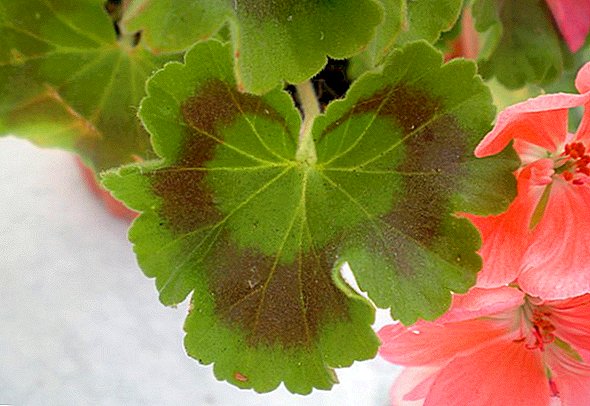
- Rhizoctonia rot. On the plant appear dented spots of dark color. The plant withers, on the spots over time you can see a grayish bloom (fungal mycelium). It is necessary to carry out treatments with chemical preparations "Vitaros", "Fundazol", "Rovral".
- Verticilous wilting. The plant is covered with yellow spots that appear at the bottom, and then spread to the top. This fungal disease can persist in the soil up to 15 years. To resolve the problem, carry out treatment with drugs "Vitaros", "Fundazol", "Rovral".
- Rust. A rusty deposit appears on the leaves in the lower part, and yellowish spots appear in the upper part of the plant. In this case, it is necessary to remove the infected parts of the plant and apply the Topaz fungicide.

- Late blight. May affect the roots or stems of bushes. The plant fades, and with the defeat of the root system, dark spots appear that have a depressed structure. To combat the blight recommended chemical agents such as "Profit-Gold" or "Ridomil."
- Root and stem rot. The plant fades. The roots are covered with dark spots, and in the neck of the root you can also notice dark spots, which later begin to rot. Infection often occurs through the soil. In this case, apply "Previkur" or "Ridomil-Gold."
Did you know? Розовая герань в эзотерике считается символом любви и семейного счастья, а это значит, что она уместна в доме, где живут семейные пары. For unmarried girls or single guys who want to find a soul mate, also recommend to have a variety with pink flowers.
Pests
The appearance of many insect pests contributes to dry air in the summer.
Most often, zonal geraniums infect such pests:
- Aphid. On the leaves appear stickiness, the leaves turn yellow. To help get rid of this pest means "Aktellik", "Fitoverm", "Akarin", "Aktara", you can use tobacco dust.
- Whitefly. The larvae of this insect in the form of a light color feed on green leaves, which causes great harm to the flower. Chemical preparations "Aktara", "Aktellik", "Fitoverm" will work well for the fight.
- Spider mite On the plant you can see a thin spider web and yellow blotches. The parts affected by this insect should be removed and the leaves washed with soapy water. With a strong lesion, you need to use the drug "Vertimek", "Aktellik".













